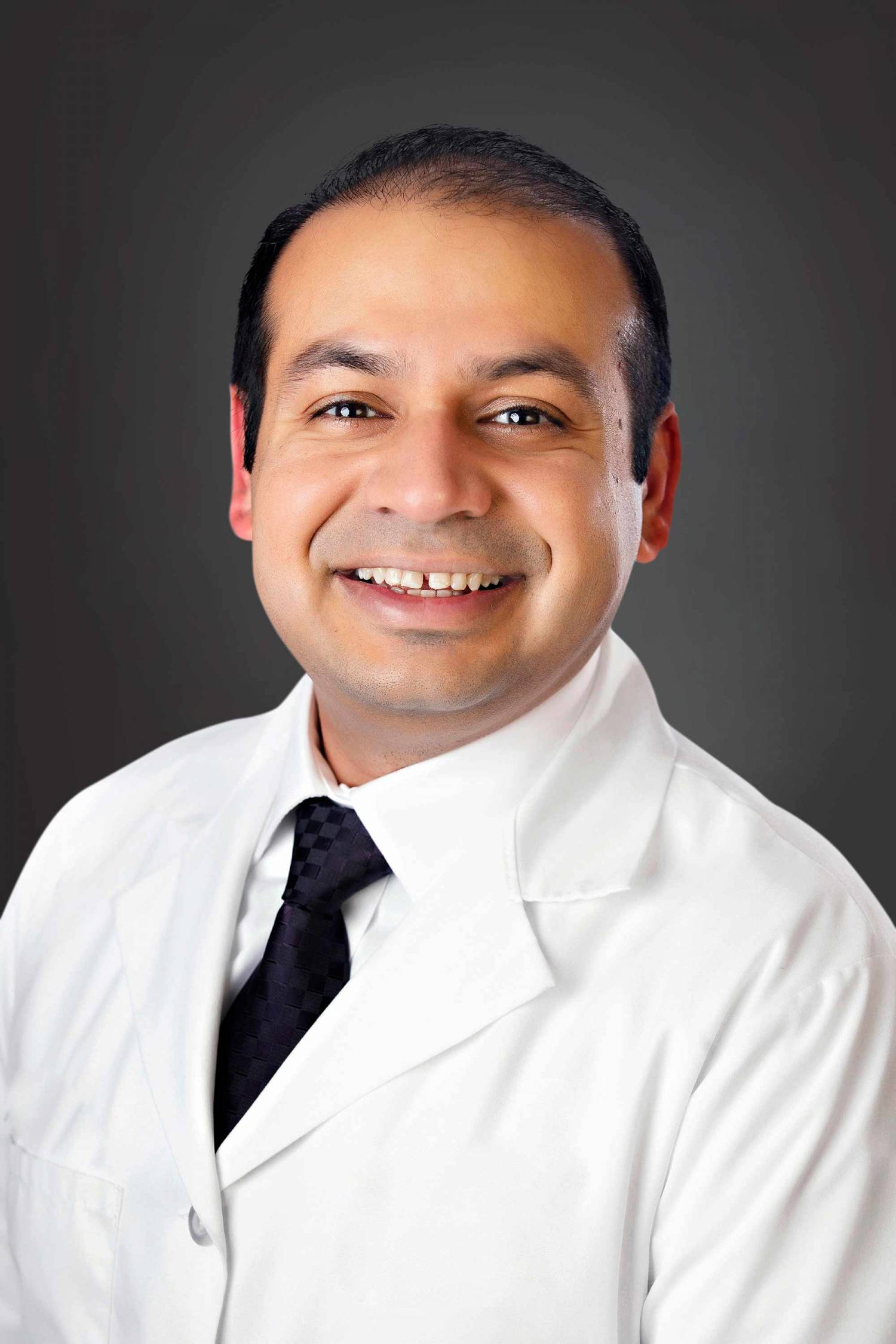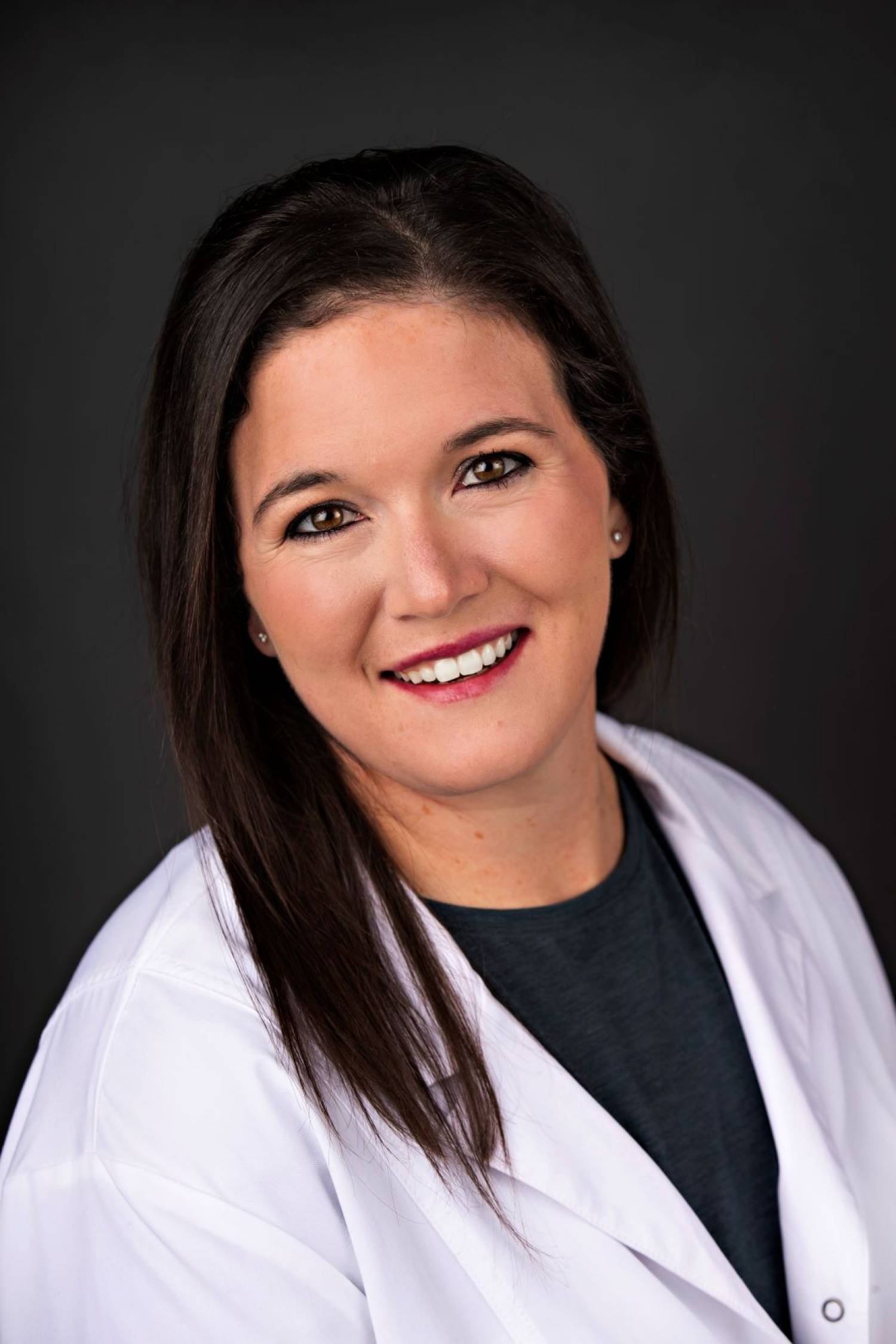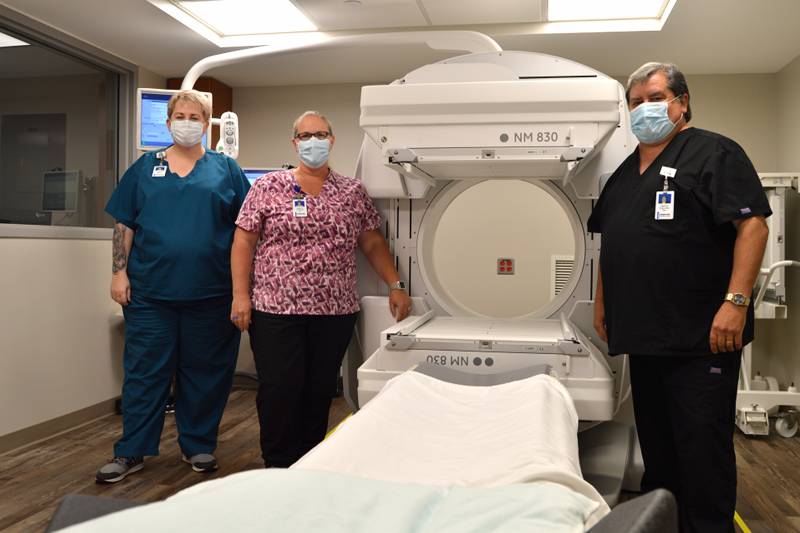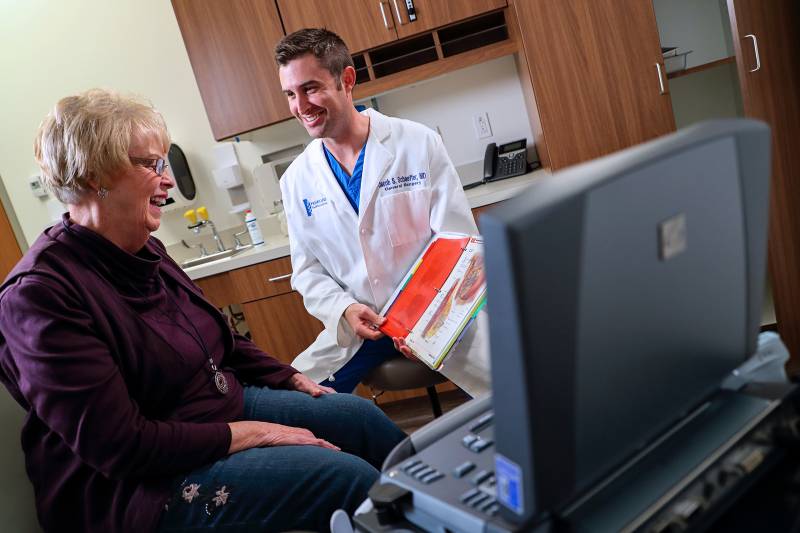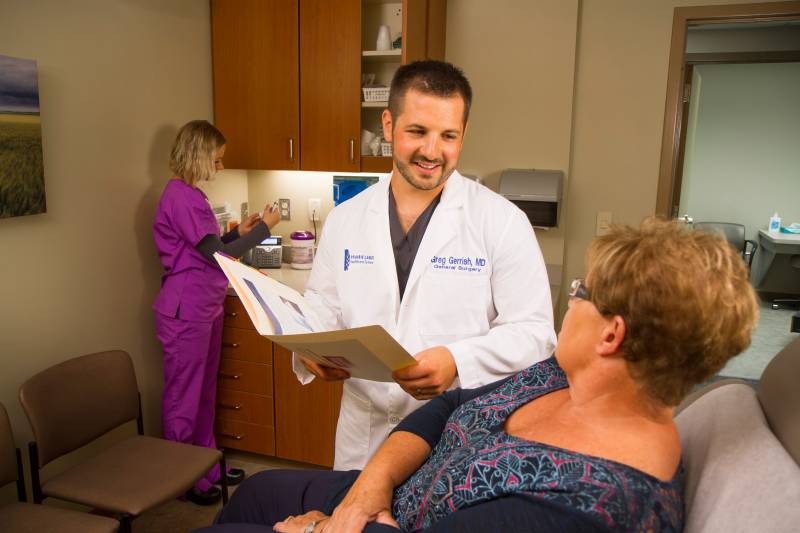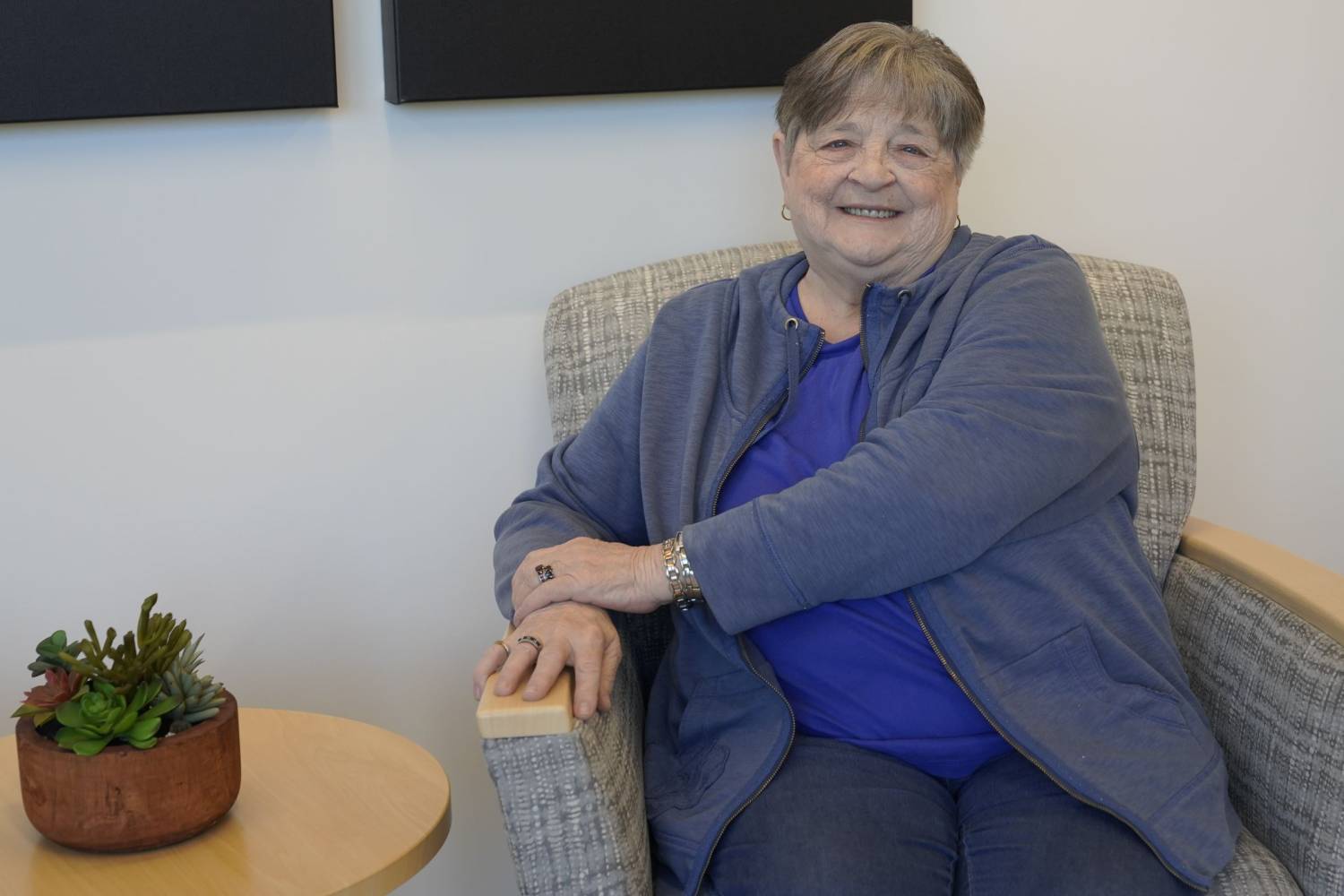Jack Hughes
Wednesday, May 01, 2013
Hospitalists
Prairie Lakes Healthcare System has a team of hospitalists who make sure that all aspects of your care during your stay are being addressed. Our hospitalists are medical doctors with advanced expertise in fields such as internal medicine and family practice. They work closely with the pharmacy staff, nurses, social workers and other medical professionals to create and complete a comprehensive plan of care for your stay at Prairie Lakes Hospital.
Our hospitalists don't replace your primary care doctor. In fact, they can partner with your doctor while you are in the hospital. The hospitalist will provide your doctor a detailed admission report and discharge summary. This allows your doctor to concentrate on the plan of treatment after you go home.

When you might see a hospitalist
- If emergency room doctors admit you as a patient, they will call a hospitalist to provide the inpatient care after you are transferred to your room.
- From the time you are admitted to the day you are discharged, the hospitalist will follow through and make sure all of your medical needs are being address.
- If a surgeon or specialist admits a patient, a hospitalist may oversee inpatient care after you are transferred to your room.
What to expect
- Each morning the hospitalist meets with the multi-disciplinary team to review your case and adjust your treatment plan accordingly.
- The hospitalist will visit you at your bedside each day, and will be available at any time. That face-to-face communication is an important part of your recovery.
- The hospitalist can expedite test results and, if needed, make changes to your treatment regardless of the time of day.
- If there's a question the hospitalist can't immediately answer, he knows where to find answers from key staff including medical and surgical specialists, case managers and other specially-trained care providers.
- If there's a patient crisis, the hospitalist can respond quickly.
Published in
Inpatient Services
Tagged under
Wednesday, May 01, 2013
Room Service
Patients and their visitors may order off of the menu located in each patient room anytime 7:30 am - 6:00 pm. Staff members work with the nutritional services team managed by Sodexo. This team includes dietitians to provide well-balanced, nutritious options.
To Order Room Service:
- Select from options provided on the menu in each room
- Pick up the phone and place an order with Nutritional Services
- Wait for a specially prepared meal to be delivered to your room
If you have any dietary restrictions, be sure to keep them in mind while ordering. Guest payments are collected at the time of service.
Published in
Nutritional Services
Tagged under
Wednesday, May 01, 2013
Prairie Lakes Cafe
Sodexo proudly serves food every day of the week.
Monday - Friday 7:30 a.m. - 6:30 p.m.
Weekends and Holidays 11:00 a.m. - 2:00 p.m.
Where is the Cafe?
Prairie Lakes Café is located on the first floor of the hospital. A variety of meals and snacks are prepared by our team. For your convenience, the café is open every day of the week, as well as on holidays.
Available Items
Hot food items are available during breakfast, lunch, and supper. Simply To-Go meals and snacks are available during all open hours. Visitors are also welcome to use the Room Service Program, payable upon delivery.
Hot Food Schedule:
-
- Breakfast - 7:30 - 10:00 a.m.
- Lunch - 11:00 a.m. - 1:00 p.m.
- Dinner - 5:30 - 6:30 p.m.
Simply To-Go
Simply To-Go offers comprehensive, convenient meals for customers in a hurry. The grab-and-go menu consists of sandwiches, salads, desserts, and microwaveable meals.
Late Menu
When hot food services end, we still have options. The Late Lunch Menu is available 1:30 - 4:30 p.m during the weekday. The menu consists of burgers, chicken strips, chicken, and grilled cheese sandwiches. Call 605-882-7872 to place an order for pick-up.
Room Service
Patients and their visitors may order off of the menu located in each inpatient book anytime 7:30 a.m. - 6:00 p.m. The team managed by Sodexo strives to provide well-balanced, nutritious options.
Vending
Vending machines are located outside the cafeteria and in Same Day Surgery's waiting area, and are available 24/7. Cash and credit payments options are available.
Published in
Nutritional Services
Tagged under
Wednesday, May 01, 2013
Core4
Change your lifestyle, change your eating habits, change your attitude and change your life!
Effective weight maintenance isn’t just about losing pounds. It’s about gaining a healthier, more rewarding lifestyle. Recently revised in 2023, the course utilizes evidenced-based research and guidelines from The Academy of Nutrition and Dietetics (AND) among other national organizations. This comprehensive program encompasses nutrition education, physical activity, and the role of behavioral therapy in weight reduction and weight management.
In addition to nutrition education and the physical activity modules, behavior modification training now consists of weekly assignments and discussions from The Intuitive Eating Workbook by Evelyn Tribole and Elyse Resch. The book addresses how to listen to your body and normalize eating.
The 12-Week CORE4 Program
- Week 1: Individual Appointment with a Registered Dietitian
- Week 2: Getting Started
- Week 3: Taking Control - Behavior Modification
- Week 4: My Plate Portion Sizes and Label Reading
- Week 5: Meal Planning and Dining Out
- Week 6: The Power of Exercise
- Week 7: Choosing Wisely: Fat, Cholesterol and Triglycerides
- Week 8: Choosing Wisely: Carbohydrates and Fiber
- Week 9: Choosing Wisely: Protein, Stress, Sleep Hydration
- Week 10: Choosing Wisely: Vitamins and Minerals
- Week 11: Grocery Store Tour
- Week 12: Moving On
Next Session
Check back later this year for information on the next Core4 Winter Session.
Body Composition Analysis (BCA)
This analysis is based on an individual’s personal information using weight, height and age. The BCA shows the composition of your body in terms of fat, muscle, and water content. This can help you concentrate on losing body fat instead of just focusing on losing pounds. A body composition analysis is completed at the beginning and the end of this 12 week program.
Program Options
For your convenience, CORE4 is offered individually or in a group setting.
Individual
This setting provides individual, personalized consultations with Prairie Lakes Healthcare System Registered and Licensed Dietitians throughout the complete program. You will meet with the dietitian and develop a personalized plan in a private, confidential setting.
Group
This setting is great for co-workers, or a group of friends who wish to go through the program together and share their support. You will receive one individual appointment with a registered dietitian at the beginning of the program to set some individual goals and to complete your initial Body Composition Analysis. These sessions will be held at the same day and time each week.
Maintain Your Success
Following the 12 week weight loss program, CORE4 continues with a 3 month weight maintenance program designed to continue you on your weight management journey. Additional topics are available as well as ongoing support.
Every step of the way, we’ll be there to guide and encourage you! Contact the Prairie Lakes Healthcare System Registered Dietitians at 605-882-7874 to schedule an appointment or to inquire when the next group sessions start.
Published in
Nutritional Services
Tagged under
Wednesday, May 01, 2013
Dietitians
Registered Dietitians are food and nutrition experts, translating the science of nutrition into practical solutions for healthy living. We offer a full range of nutritional services and programs, ranging from one-on-one counseling to group programs.
Anyone can call themselves a nutritionist, but only a registered dietitian (RD) or registered dietitian nutritionist (RDN) has completed multiple layers of science-based education and training established by the Accreditation Council for Education in Nutrition and Dietetics. Watch the video to learn more about what makes RDs unique:
Services
One-On-One Counseling
Our dietitians guide clients through a lifestyle plan designed specifically for each individual's specific diet needs. One-on-one counseling offers clients the support and education needed to successfully make desired lifestyle changes. It also includes individual evaluations and progress check-ups.
Body Composition Analysis
Based on an individual's personal information, weight and height, the Body Composition Analysis (BCA) shows what a person's body is made up in terms of fat, muscle, water content and bone structure. This information is helpful in determining a course of action for improving health.
Weight Management
Core4 is an effective weight management program that isn't just about losing pounds but gaining a healthier, more rewarding lifestyle. During this twelve-week program our registered dietitians will focus on boosting your overall health by relying on scientific methods to train you to improve your eating habits, lifestyle and activity choices- for good!
Meeting Your Needs
Health needs can be unique. Our dietitians can help you with questions regarding the following:
- Food allergies
- Lifelong nutrition guidelines
- Separating food facts from fiction
- Weight reduction/management
Individuals may also receive counseling on health conditions such as:
- Cancer
- Diabetes
- Heart disease
- Kidney disease
- Obesity
For information on these or other nutrition issues, please call our office today at 605-882-7874.
Published in
Nutritional Services
Tagged under
Wednesday, May 01, 2013
Nuclear Medicine
Nuclear Medicine uses small amounts of radioactive materials called radiopharmaceuticals or radiotracers that are either injected, inhaled, or swallowed. These radiopharmaceuticals are used to help in the diagnosis and treatment of heart, gastrointestinal, endocrine, bone, lung, renal disease, and many types of cancer.
How it works
Nuclear Medicine uses a special camera called a Gamma camera. The gamma camera itself does not give off any type of radiation. The radiopharmaceutical that is given to the patient gives off a small amount of energy in the form of gamma rays. The gamma camera detects this energy, and with the help of a computer, creates pictures that give both the structure and function of the organs and tissues in the body that are being scanned.
What can I expect during my Nuclear Medicine exam?
Nuclear Medicine procedures are usually performed as an outpatient, but occasionally also performed on hospitalized patients as well. When you arrive at the hospital you will be sent to the radiology department where the nuclear medicine department is also located. Once you have arrived in radiology, one of the nuclear medicine technologists will come and get you to bring you down to the nuclear medicine area. Depending on the type of nuclear medicine exam you are having, the radiopharmaceutical will then be injected intravenously, swallowed or inhaled.
When it is time for your scan to begin, you will lie flat on the camera bed and the scanner will take a series of images. The camera may rotate around you or it may stay in one position. While the camera is taking pictures you will need to remain still. At times the camera may move very close to your body.
How long does it take?
The length of time the procedures take varies greatly, depending on the type of exam. Actual scanning times for nuclear medicine exams can take anywhere from 20 minutes to several hours.
Except for the IV start, most nuclear medicine procedures are painless and are rarely associated with significant discomfort or side effects.
Unless your physician tells you otherwise, you may resume your normal daily activities after your nuclear medicine procedure. If any special instructions are needed, you will be told by the technologist.
Through the natural process of decay, the small amount of radiopharmaceutical in your body will lose its radioactivity over time.
Published in
Radiology
Tagged under
Wednesday, May 01, 2013
Ultrasound
Ultrasound technology uses sound waves for a safe, non-invasive way to “see” inside the body. The sound waves are used to produce images of the internal organs, blood vessels and tissues of the body. Ultrasound technology offers incredible clarity, accuracy and precision to provide optimal images for the Radiologist or Cardiologist to interpret.
Prairie Lakes offers multiple types of Ultrasound imaging, including gynecologic, abdominal, vascular and cardiac. Stroke screening studies are also available to visualize the carotid arteries, aorta and leg vessels to aid in the detection of potentially life-threatening conditions or pre-stroke symptoms.
General Ultrasound (Abdominal/Gynecologic)
What should I expect?
A small transducer with water based gel is placed directly onto your skin. Images are produced when the sound waves are directed into the body and then reflected back to the transducer that measures and computes them.
How long will the exam take?
The average general ultrasound exam takes about 30 minutes to perform. Some exams may take longer due to the complexity of the exam such as additional detailed images, measurements and number of organs being measured.
After your exam, your images will be sent to a highly trained, board certified Radiologist for interpretation and dictation. A final report will be sent directly to your ordering physician’s office.
Vascular Ultrasound
What should I expect?
A small transducer with water based gel is placed directly onto your skin. Images are produced when the sound waves are directed into the body and then reflected back to the transducer that measures and computes them. Blood pressure tests using continuous wave Doppler are also performed to check the circulation of the blood in the extremities.
Published in
Radiology
Tagged under
Wednesday, May 01, 2013
Breast Services
Breast cancer remains the most frequently diagnosed cancer in women. Early detection through regular mammograms, improved screening methods, clinical and self exams are saving thousands of lives every year. If a lump deep inside the breast shows up on a mammogram, your doctor can order a minimally invasive breast biopsy.
When a lump is detected, many have thoughts of uncertainty. Prairie Lakes can help patients through this uncertain time and assist in keeping appointments close to home. A minimally invasive breast biopsy can provide a very early diagnosis before breast tumors have a chance to fully develop. Many times these procedures can be scheduled for the next day with no referral by calling the Prairie Lakes General Surgery Clinic at 605-882-6850.
Minimally invasive procedures leave little to no scarring and can be performed in less than an hour. The removed tissue is then analyzed in town at the Prairie Lakes Laboratory for quick results.
About Minimally Invasive Breast Biopsies
Minimally invasive procedures are much less invasive than surgical biopsies. Most importantly, they can provide a very early warning before breast tumors have a chance to fully develop.
- Stereotactic mammography pinpoints the exact location of a breast lesion by using a computer and images taken from two different angles. Using these computer coordinates, a needle is inserted through the skin and is advanced into the lesion. Tissue samples are removed with a vacuum assisted core biopsy device.
- In ultrasound-guided breast biopsy, ultrasound imaging is used to help guide the biopsy vacuum-assisted core biopsy device to the site of the abnormal growth
And it's important to remember that most women who have a biopsy are not diagnosed with cancer. More than 80 percent of all breast lesions identified for biopsy are diagnosed benign or noncancerous and present no health risk to the patient.
What is a Core Biopsy?
A Core Biopsy is the removal of a small piece of tissue for microscopic examination to study the makeup of cells. The entire procedure usually takes about 30 minutes and is completed in five steps:
- Imaging the breast to identify the biopsy area.
- Numbing the breast with medicine.
- Inserting the biopsy device in the breast to retrieve tissue samples
- Performing the biopsy.
- Marking the biopsy site for future reference. Depending on the imaging system used to help guide your biopsy, you may have your breast compressed similarly to the compression used during a mammogram, or a gel may be applied if ultrasound imaging is used.
Understanding Your Procedure
Before Your Procedure
You should inform your doctor of any medications you are currently taking whether prescription or over-the-counter. This includes aspirin, ibuprofen, blood thinners such as Coumadin, natural herbs, vitamin E and other vitamins. Some of these medications may need to be temporarily stopped several days prior to your biopsy. Also, list any allergies you may have. Let your doctor know if you are allergic to local anesthetics, tape, betadine or metal.
During Your Procedure
Note: If you are having an MRI-guided biopsy procedure, you will have an IV inserted into your arm so that a contrast agent can be used to see small details in the breast tissue.
After you have been properly positioned for your biopsy, your physician and a technologist will image the breast and locate the area to be biopsied. Your skin will be cleansed with antiseptic and the area to be biopsied will be numbed. Sometimes, a very small nick is made in the skin to help the biopsy device enter the breast with ease. You may feel some pressure as the device is positioned, but most women report feeling no pain.
The actual biopsy will take a very short time. Multiple samples will be taken. You may hear a "beep" or "click" as tissue samples are collected. The doctor may place a marker in the tissue at the biopsy site for future reference to identify the exact location of the biopsy. The marker is made of titanium and poses no health or safety risk. You will not feel or notice the marker after placement.
After your procedure
Pressure will be applied to the biopsy site to help prevent bruising. This usually takes only a few minutes. A small adhesive bandage or adhesive gel will be placed over the nick and you will be provided with a cold pack to apply over the biopsy site. In some instances, a compression wrap bandage may be placed around the chest to minimize chances of swelling or bruising. The collected tissue samples will be sent to the lab for analysis.
The doctor may prescribe a non-aspirin pain reliever to help alleviate any possible discomfort and detailed post-biopsy instructions will be provided. Most women can resume normal daily activities within 24 hours following their procedure. Your doctor will contact you after receiving your biopsy results and then instruct you on any followup care that may be necessary.
Frequently Asked Questions
Q: How much breast tissue will be removed? A: Only the necessary amount of tissue needed to ensure an accurate diagnosis.
Q: How long will the biopsy take? A: Biopsy time varies from case to case. The average biopsy procedure takes 30 - 45 minutes from the time you enter the exam room until the time you leave the hospital.
Q: Will I have a scar? A: Visible evidence of where the biopsy device was inserted into the breast is extremely small and fades to a natural skin tone over time.
Q: Will I experience any pain during the procedure? A: You might feel a slight sting or pinch when the numbing medication is being inserted into the breast. Numbing the breast prior to the biopsy causes the rest of the procedure to be relatively pain free, however you may feel some pressure or pinching during the actual biopsy.
Q: What possible side effects should I know about? A: Your breast may be slightly tender and you may experience some mild bruising at the biopsy site. You will be provided with post-biopsy care instructions.
Fact: Most women who have a biopsy are not diagnosed with cancer. More than 80% of all breast lesions identified for biopsy are diagnosed benign or noncancerous and present no health risk to the patient.
Published in
Surgical Services
Tagged under
Wednesday, May 01, 2013
Diagnostic and Interventional Angiogram
Prairie Lakes Healthcare System has become a leading provider in this region for diagnostic and interventional angiogram procedures to find and treat blockages or narrowing of blood vessels, often the arteries that supply blood to the heart muscle.
During the procedure, a dye that is visible on X-ray is injected into your arteries or veins. The X-ray will quickly show where the problems are. If it is a diagnostic procedure only, that information will be used by your medical team to devise a course of treatment. However, you can also receive treatment during the same procedure. The doctor will run a tiny tube to through your blood vessels to the site of the blockage, then insert a small permanent tube called a stent to open the artery and keep it open.
The diagnostic angiogram leaves no traces at all. The interventional angiogram's only evidence is a small incision at the point of entry, usually the thigh. And restoring the flow of blood to the heart has immediate benefits. Patients often report feeling healthier and more energetic as soon as the procedure is done.
Published in
Surgical Services
Tagged under
Wednesday, May 01, 2013
Colonoscopy
The American Cancer Society recommends those at average risk* for colorectal cancer to start regular screenings at age 45. A colonoscopy doesn’t take a lot of time, but this simple procedure offers a big payback: peace of mind. Colorectal cancer is deadly, but treatable if it’s caught early. The majority of colonoscopic exams turn up no lesions at all, and in many other cases polyps and other suspicious growths can be removed during the colonoscopy.
A colonoscopy is an endoscopic examination of the rectum, colon and part of the small intestine. A tiny camera on the end of a long flexible tube, lets the doctor perform a non-surgical, real-time examination of your colon.
The entire procedure takes little more than a couple of hours. The biggest challenge is the preparation beforehand, and it’s important to follow the prep directions carefully. Sedation or anesthesia ensures that the process is painless. You wake up a short time later, and you’re soon ready to go home.
*According to the American Cancer Society, people are considered to be at average risk if they do not have:
- A personal history of colorectal cancer or certain types of polyps
- A family history of colorectal cancer
- A personal history of inflammatory bowel disease (ulcerative colitis or Crohn’s disease)
- A confirmed or suspected hereditary colorectal cancer syndrome, such as familial adenomatous polyposis (FAP) or Lynch syndrome (hereditary non-polyposis colon cancer or HNPCC)
- A personal history of getting radiation to the abdomen (belly) or pelvic area to treat a prior cancer
Direct Access Colonoscopy
If you qualify, a Direct Access Colonoscopy can save you time and money since a separate consultation visit is not needed.
NOTE: This program is only available for colonoscopies in the Watertown, South Dakota service area.
Contact us to see if you qualify for a Direct Access Colonoscopy. Just fill out the form below or call the General Surgery Clinic at 605-882-6852 to talk to a nurse.
Note: Upon submission of this form, a nurse will contact you to discuss if you qualify for a Direct Access Colonoscopy.
Published in
Surgical Services
Tagged under
We See You living your life
And we're here for you with the latest technology and medical expertise you need to live your best life possible.
Orthopedics
Glacial Lakes Orthopedics is now Prairie Lakes Orthopedics.
Join Our Team
Over 600 staff members and 200 volunteers make our regional healthcare system one of the top rural health systems.
Available Services
Prairie Lakes Healthcare System offers a wide range of medical services for people who call northeastern South Dakota and western Minnesota home.
Surgical Services
Our team is here for urgent procedures like appendix removal and scheduled surgeries like joint replacement.
Dermatology
Feel good about your skin’s health. Our specialists offer individualized treatment plans and cosmetic options.
We can help you find a doctor. Call 605-882-7000 or search online.

